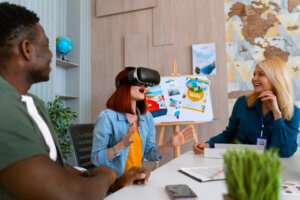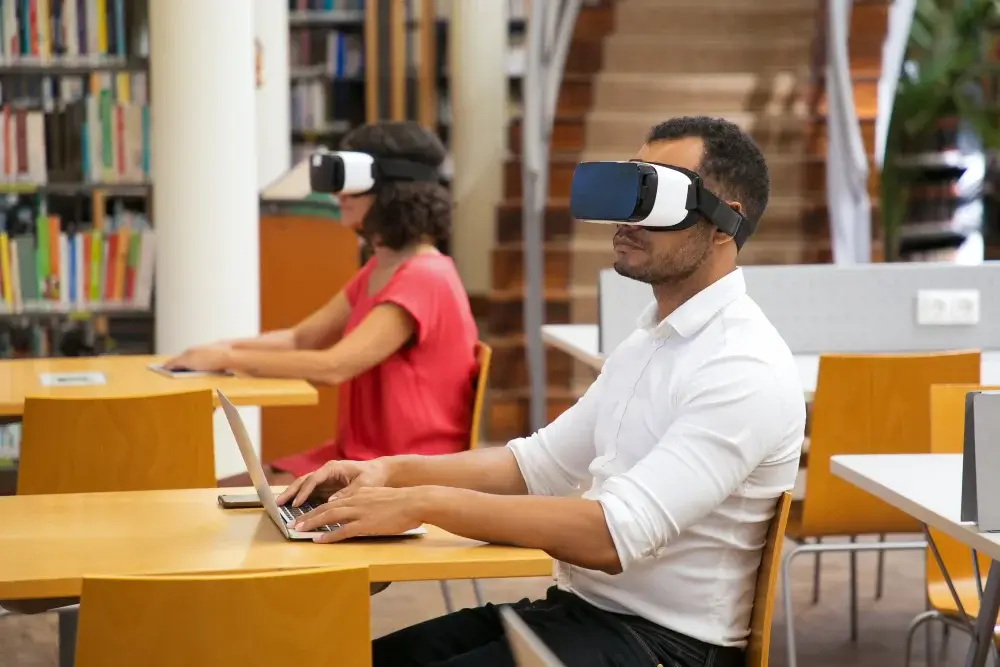Virtual Reality for Education: Creating Engaging and Immersive Learning Experiences

Virtual reality technology has been revolutionizing diverse industries, from gaming and entertainment to healthcare and beyond. However, one domain where it demonstrates immense promise is education. Virtual reality, commonly known as VR, can transport students to various locations and scenarios, providing them with a fully immersive and captivating learning experience. As technology becomes more prevalent in classrooms, educators are constantly seeking ways to elevate their teaching methodologies and maintain student interest and motivation. VR presents a distinctive opportunity to achieve this objective by constructing dynamic and interactive learning environments that can captivate and inspire students. In this article, we will delve into the advantages of incorporating virtual reality in education and explore how it can reshape the future of learning. From its impact on student engagement and retention to its potential for creating lifelike simulations, we will unravel the myriad ways in which VR can be harnessed to forge potent and effective educational experiences. Let’s embark on a journey into the realm of virtual reality for education and unravel how it has the potential to shape the future of learning.
The Transformative Power of VR in Educational Content Enhancement
Virtual reality (VR) stands out as a potent tool for enhancing educational content, fundamentally altering the way students absorb and interact with educational material. By immersing students in virtual environments and facilitating interactive experiences, VR introduces a dynamic and immersive dimension to the learning process. With VR headsets and controllers, students can navigate through intricate concepts and subjects in a three-dimensional space, fostering a profound understanding of abstract and challenging topics. Furthermore, VR can replicate real-world scenarios, offering practical training opportunities in fields like medicine, engineering, and architecture and providing valuable hands-on experience without the need for costly equipment or physical resources. Overall, VR holds enormous potential for revolutionizing traditional educational approaches and crafting engaging and immersive learning experiences for students across all age groups.
Crafting interactive and immersive lessons
In the educational landscape, the significance of delivering interactive and immersive lessons has soared, playing a pivotal role in enhancing student engagement and augmenting learning outcomes. Through the integration of cutting-edge technologies such as virtual reality (VR), educators can fabricate captivating and dynamic learning experiences. By transporting students to virtual worlds or simulated environments, VR facilitates active participation and hands-on exploration, enabling learners to interact with objects, scenarios, and concepts in a tangible and meaningful manner. This interactive approach not only sparks curiosity and motivation but also nurtures critical thinking, problem-solving, and collaboration among students. Moreover, the immersive nature of VR cultivates a deeper level of understanding and retention as learners are fully immersed in the subject matter, experiencing it firsthand. By leveraging the power of VR in educational settings, educators can furnish students with a transformative learning experience that transcends traditional teaching methods, instilling a lifelong passion for knowledge acquisition and exploration.
Tailoring Lessons for Diverse Learners
To cultivate an inclusive and effective learning environment, educators must tailor lessons to accommodate the diverse needs and learning styles of their students. Each learner possesses unique strengths, weaknesses, and preferences, and customizing instruction to address these individual differences significantly enhances engagement and learning outcomes. Employing a range of instructional approaches, such as visual aids, hands-on activities, group discussions, and multimedia resources, enables educators to cater to different learning modalities, providing multiple entry points for students to grasp and apply new concepts. Additionally, integrating formative assessments and feedback loops allows for ongoing evaluation of student progress, facilitating adjustments in instruction to better meet specific needs. Embracing the practice of customizing lessons for diverse learners fosters a supportive and inclusive learning environment where every student has the opportunity to thrive and succeed.
Real-World Simulations for Practical Learning
Real-world simulations for practical learning present an innovative and immersive approach to education, enabling students to apply theoretical knowledge to real-life scenarios. These simulations bridge the gap between classroom learning and practical application, offering students the opportunity to engage in hands-on experiences in a safe and controlled environment. Leveraging advanced technologies such as virtual reality and augmented reality, educators can fabricate realistic simulations mirroring real-world situations, facilitating the development of essential skills and problem-solving abilities. Whether practicing medical procedures, simulating business scenarios, or conducting virtual science experiments, real-world simulations not only enhance student engagement but also foster deeper understanding and retention of knowledge. By integrating these cutting-edge tools into education, educators empower students to become active participants in their learning journey, preparing them for the challenges of the modern world.
Captivating Students through VR Storytelling
In the digital era, virtual reality (VR) storytelling emerges as a compelling tool for engaging students in the learning process. By immersing students in virtual environments, VR storytelling transcends traditional textbooks and lectures, allowing students to actively participate in their own learning journey. Through VR experiences, students can explore historical events, witness scientific phenomena, or step into the shoes of characters from literature. This immersive approach captivates students’ attention, making learning more exciting and memorable. Moreover, VR storytelling encourages critical thinking and empathy, as students understand different perspectives and make decisions within the virtual world. By leveraging the power of VR storytelling, educators create engaging and immersive learning experiences that inspire curiosity, foster creativity, and ultimately enhance student achievement.
Accessing remote and hard-to-reach locations
To broaden the horizons of education, virtual reality (VR) has the potential to transport students to remote and hard-to-reach locations. Immersive technology allows students to explore the depths of the ocean, venture into dense rainforests, or visit ancient archaeological sites—all from the comfort of their classroom. Accessing these remote locations enables students to witness firsthand the wonders of the world that would otherwise be inaccessible. With VR, geographical barriers no longer limit learning, as students embark on virtual field trips that provide a rich and authentic experience. By bringing these remote locations into the educational realm, virtual reality enables students to develop a deeper understanding and appreciation for different cultures, environments, and natural phenomena, broadening their perspectives and cultivating a sense of stewardship towards the planet.
Global Collaboration and Experience Sharing
In today’s interconnected world, global collaboration and experience sharing have become more accessible than ever. Advanced communication technologies and platforms enable students and educators from different corners of the globe to connect and collaborate effortlessly. This global collaboration fosters cultural exchange, understanding, and the sharing of knowledge and ideas on a global scale. Through virtual classrooms and online learning communities, students engage in discussions, projects, and group work with peers from different countries, broadening their perspectives and gaining valuable insights into diverse cultures, perspectives, and approaches to learning. This exchange of ideas and experiences not only enhances the educational experience but also prepares students to thrive in a globalized workforce, where collaboration and understanding of different cultures are vital. Embracing the power of global collaboration creates a more inclusive and interconnected educational landscape, empowering learners to become informed and engaged citizens of the world.
Envisioning the Future of Education through VR
As technology advances at a rapid pace, virtual reality (VR) stands poised to revolutionize the field of education. Its ability to create immersive and interactive learning experiences holds the potential to enhance student engagement, improve information retention, and provide opportunities for experiential learning previously deemed unimaginable. Educators, through the use of VR, can transport students to historical landmarks, take them on virtual field trips to distant places, and simulate real-life scenarios to develop critical thinking and problem-solving skills. The immersive nature of VR actively involves students in their learning, making education more engaging and relevant. Furthermore, VR caters to different learning styles, offering personalized learning experiences that allow students to learn at their own pace and in their own way. While VR in education is still in its early stages, the future promises tremendous potential for this technology to transform the way we teach and learn, ushering in a new era of engaging and immersive educational experiences.
In Conclusion
The incorporation of virtual reality in education has the potential to revolutionize the way we learn and engage with information. By creating immersive and interactive experiences, students can attain a deeper understanding and retention of complex concepts. As technology progresses, educators must explore and embrace new tools that can enhance the learning journey for their students. Virtual reality emerges as a powerful tool with the ability to transform traditional education, paving the way for a dynamic and engaging future of learning.
